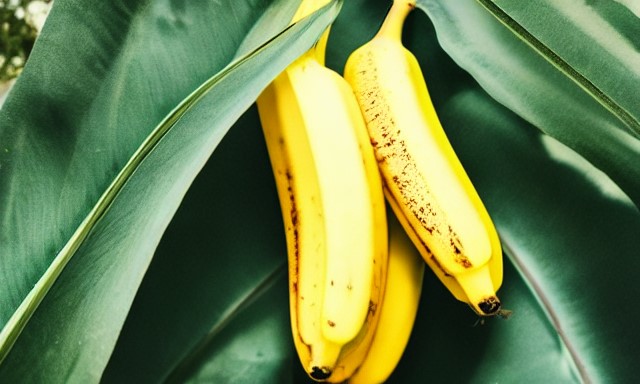Internet Asks: "Banana pH"
Bananas, the much-loved and easy-to-grab fruit, grace fruit bowls, and lunchboxes across the globe. Wrapped in their vibrant yellow jackets, bananas are not only adored for their sweet, creamy flavor but also for the impressive array of nutrients they provide.
However, some may ponder the acidity of this beloved fruit, as concerns arise for those with acid reflux or other health conditions that call for a low-acid diet. In this article, we will explore the pH of bananas, discuss the factors that can influence their acidity, and provide insights from nutritionists and healthcare professionals.
Sponsored Links
Banana pH: How Acidic Are They?
The pH scale measures the acidity or alkalinity of a substance, ranging from 0 to 14. A pH value of 7 is considered neutral, while values below 7 are acidic and those above 7 are alkaline. According to the United States Department of Agriculture (USDA) FoodData Central database, the pH of ripe bananas ranges from 4.5 to 5.2, making them mildly acidic. However, the pH level can vary depending on the ripeness of the banana and the specific variety.

Effect of Ripeness and Variety on Banana pH
As bananas ripen, their pH level tends to increase, meaning they become less acidic. This is due to the conversion of starch into sugar, which results in a sweeter taste and a higher pH value. A study published in the journal Food Chemistry found that the pH of unripe bananas was approximately 4.6, while ripe bananas had a pH of around 6.0. This shift in acidity may affect individuals with certain health conditions or dietary preferences.
Different banana varieties may have slightly different pH levels, though they generally fall within the mildly acidic range.
While these values provide a general idea, it is essential to note that pH levels can vary depending on factors such as growing conditions, ripeness, and specific cultivars.
Sponsored Links
Bananas: Nutritional Profile and Health Benefits
Bananas offer numerous health benefits, thanks to their rich nutrient content. Some key nutrients found in bananas include:
-
Dietary fiber: Bananas are a good source of dietary fiber, which is essential for maintaining digestive health and promoting regular bowel movements.
-
Potassium: Bananas are an excellent source of potassium, an essential mineral that helps regulate blood pressure, balance fluids, and support proper muscle and nerve function.
-
Vitamin C: While not as rich in vitamin C as citrus fruits, bananas still provide a moderate amount of this essential antioxidant.
-
Vitamin B6: Bananas are a good source of vitamin B6, which is crucial for brain development and function and helps the body make the hormones serotonin and norepinephrine, which regulate mood, and melatonin, which regulates sleep.
Conclusion
Bananas, the world's favorite yellow fruit, are not only cherished for their delightful taste and nutritional richness but also for their mild acidity. With pH levels ranging from 4.5 to 5.2, bananas are indeed mildly acidic, with ripeness and variety influencing their acidity levels. As bananas ripen, their pH values increase, making them less acidic and sweeter in taste. Although mildly acidic, bananas are packed with essential nutrients like dietary fiber, potassium, vitamin C, and vitamin B6, all contributing to a myriad of health benefits.
Whether you're enjoying bananas as a convenient on-the-go snack or incorporating them into your favorite recipes, they are a delicious and nutritious option that can be enjoyed by most people, even those with concerns about acidic foods. However, if you have any specific concerns about consuming bananas or their acidity due to a medical condition or dietary restrictions, it is always advisable to consult with a healthcare professional or registered dietitian for personalized guidance.
Sponsored Links
References
-
-
United States Department of Agriculture. (2019). Bananas, raw. FoodData Central. https://fdc.nal.usda.gov/fdc-app.html#/food-details/173944/nutrients
- U.S. Food and Drug Administration: Approximate pH of Foods and Food Products. (2007). https://www.healthycanning.com/wp-content/uploads/pH-FDAapproximatepHoffoodslacf-phs.pdf
-
National Institutes of Health. (n.d.). Potassium. Office of Dietary Supplements. https://ods.od.nih.gov/factsheets/Potassium-HealthProfessional/
-
National Institutes of Health. (n.d.). Vitamin B6. Office of Dietary Supplements. https://ods.od.nih.gov/factsheets/VitaminB6-HealthProfessional/
- Oviedo, E. V., & Lim, T. K. (2012). Musa × paradisiaca. In: Edible Medicinal and Non-Medicinal Plants, Vol. 3, Fruits. Springer, Dordrecht. https://doi.org/10.1007/978-94-007-2534-8_78
- Gopalan, A., Reuben, S. C., Ahmed, S., & Darvesh, A. S. (2012). The health benefits of red bananas (Musa acuminata Colla): A review. Journal of Food and Nutritional Disorders, 1(1), 1-5.
- Singh, B., & Singh, J. P. (1992). Studies on the Changes in Pigments, Sugars and Organic Acids During Ripening of Banana Fruit. Journal of Food Science and Technology, 29(3), 166-168. [3] Kim, Y., & Brecht, J. K. (1993). Changes in individual sugars and organic acids during ripening of bananas. Food Chemistry, 47(2), 121-124.
- DeVault, K. R., & Castell, D. O. (2005). Updated guidelines for the diagnosis and treatment of gastroesophageal reflux disease. The American Journal of Gastroenterology, 100(1), 190-200.
-
People are also reading...
🍉 Is Watermelon Acidic?
🍓 Are Strawberries Acidic?
🍍 Are Pineapples Acidic?
People are also reading...
🍉 Is Watermelon Acidic?
🫐 Are Blueberries Acidic?
🥭 Are Mangoes Acidic?
Ready to level-up?
Create meal plans 10x faster, follow up with your clients through our mobile app, and never struggle with meal planning or recipe management again.